圖文詳解vue中proto文件的函數(shù)調(diào)用
在src文件夾下新建proto文件夾用以存放所有的.proto文件。在proto文件夾下打開終端,輸入如下命令:
//進(jìn)入proto文件夾執(zhí)行下列編譯,將helloworld.proto替換為當(dāng)前的.proto文件名protoc -I=. helloworld.proto --js_out=import_style=commonjs,binary:. --grpc-web_out=import_style=commonjs,mode=grpcwebtext:.
一個(gè).proto文件(helloworld.proto)編譯后生成2個(gè)js文件:
helloworld_pb.js helloworld_grpc_web_pb.js2、編譯后的proto文件中變量及函數(shù).proto中函數(shù)的結(jié)構(gòu),主要由函數(shù)及參數(shù)2部分組成:
service Greeter{ rpc AddEmployee(Employee) returns (EmployeeID) {} // 提交員工信息一元消息}//發(fā)送請求的數(shù)據(jù)類型結(jié)構(gòu)message Employee{ string name = 1; int32 age = 2;}//返回函數(shù)處理結(jié)果的類型結(jié)構(gòu)message EmployeeID{ int32 id = 1;}
函數(shù)部分
編譯之后,名稱為“service Greeter”的服務(wù)及函數(shù)AddEmployee的定義在helloworld_grpc_web_pb.js文件中:
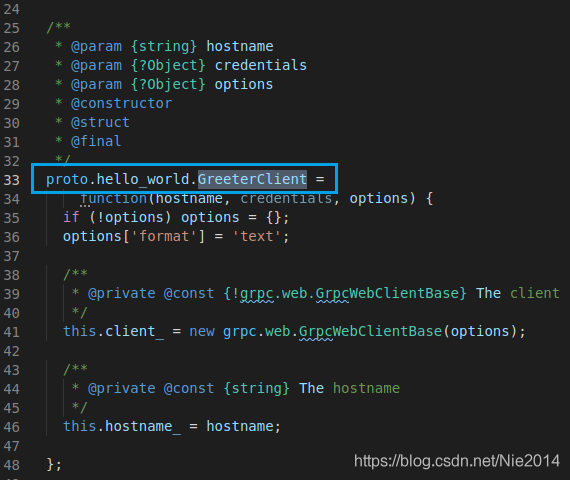
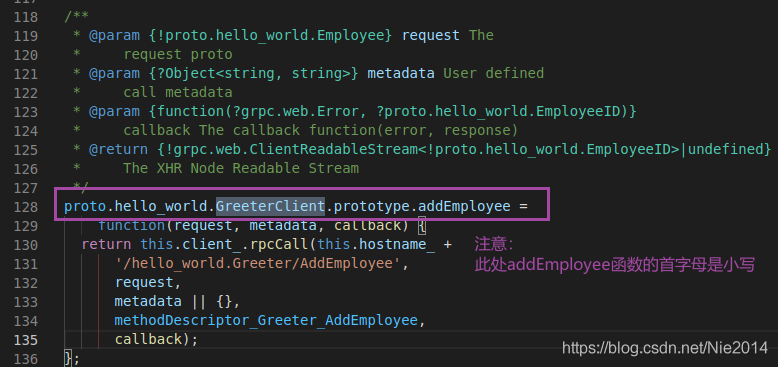
參數(shù)部分
Employee及EmployeeID的參數(shù)定義在helloworld_pb.js中:
1、發(fā)送請求的參數(shù)Employee
Employee的第一個(gè)參數(shù)name 函數(shù)形式如下(此處是請求參數(shù),使用set格式):
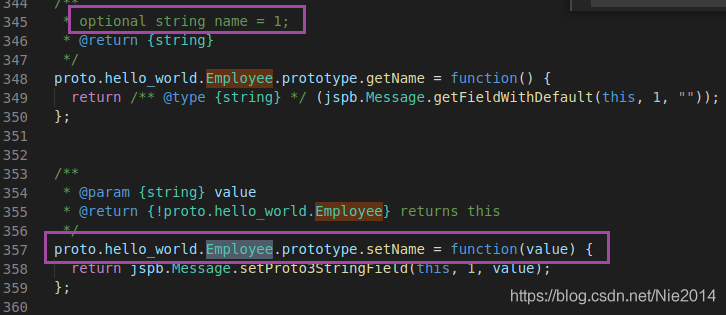
Employee的第二個(gè)參數(shù)age函數(shù)形式如下(此處是請求參數(shù),使用set格式):
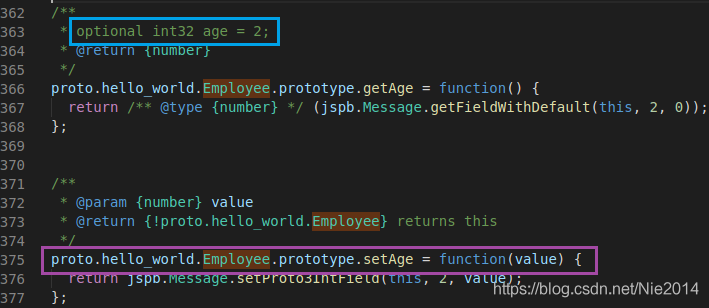
2、返回結(jié)果參數(shù)EmployeeID
EmployeeID返回結(jié)果只有id這一個(gè)參數(shù),函數(shù)結(jié)構(gòu)如下(此處是返回參數(shù),使用get格式):
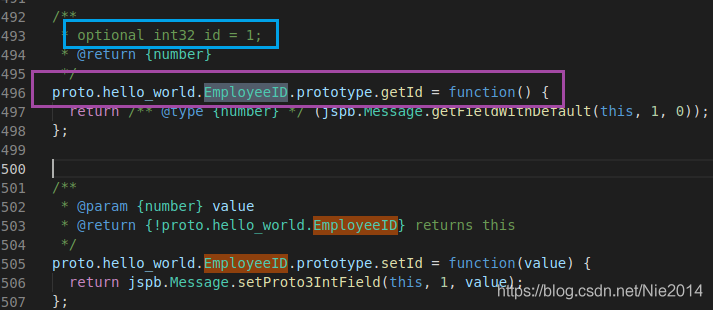
調(diào)用proto中的函數(shù)
一個(gè)簡單的調(diào)用示例如下(點(diǎn)擊button按鈕,產(chǎn)生一個(gè)單擊事件get_helloworld):
<el-button type='primary' @click='get_helloworld'> hello_world</el-button>
get_helloworld() { this.client = new GreeterClient('http://192.168.10.102:8181', null, null); // 創(chuàng)建請求參數(shù)并賦值 var request = new Employee(); request.setName('World'); request.setAge(11); // 調(diào)用客戶端相應(yīng)的grpc方法,發(fā)送grpc請求,并接受后臺(tái)發(fā)送回來的返回值 this.client.addEmployee(request, {'my-service-header': 'test_service'}, (err, response) => {if (err) { console.log(`Unexpected error for addEmployee: code = ${err.code}` +`, message = '${err.message}'` );} else { console.log(response.getId()); // 打印返回的信息} });},
此時(shí)可以在控制臺(tái)中看到夠返回的ID數(shù)值。
將返回結(jié)果顯示在界面中
函數(shù)的返回結(jié)果都要以合適的形式展示在界面的控件中,此處以:
1、table控件
table控件是使用比較頻繁的數(shù)據(jù)展示控件,此處示例proto代碼如下(返回列表數(shù)據(jù)格式,且包含枚舉變量):
rpc SelectAllCameras(SelectAllCamerasRequest) returns(SelectAllCamerasResponse){}// 查詢所有攝像機(jī)設(shè)備message SelectAllCamerasRequest{ int32 page_index = 1; int32 page_size = 2; string condition = 3;}//返回查詢結(jié)果,返回一個(gè)CameraInfo 的數(shù)組,CameraInfo 中又包含枚舉類型CameraBrandmessage SelectAllCamerasResponse{ CodeErr enumErrorNo = 1; repeated CameraInfo cameraArray = 2;}// 攝像機(jī)信息message CameraInfo{ string szCameraUID = 1; // uid string szName=2; // 名稱 東門口攝像機(jī) CameraBrand enumCameraBrand=3; // 品牌}// 攝像機(jī)品牌enum CameraBrand { DEFAULT_CAMERA_BRAND = 0; HIKI_VISION= 1; DAHUA = 2; UNIVIEW = 3;}
1、導(dǎo)入頭文件
import { device_register_serviceClient } from '../proto/device_manage_grpc_web_pb';import { SelectAllCamerasRequest,} from '../proto/device_manage_pb';
<el-table :data='caminfoTable' ref='caminfoTable' > <el-table-column type='index' :index='table_index' label='序號(hào)' width='50'></el-table-column> <el-table-column prop='UID' label='UID' align='center'> <template slot-scope='scope'> <span>{{scope.row.getSzcamerauid()}}</span> </template> </el-table-column> <el-table-column prop='szName' label='相機(jī)名' align='center'> <template slot-scope='scope'> <span>{{scope.row.getSzname()}}</span> </template> </el-table-column> <el-table-column prop='enumCameraBrand' label='相機(jī)品牌' align='center'> <template slot-scope='scope'> <span>{{CameraBrand[scope.row.getEnumcamerabrand()].label}}</span> </template> </el-table-column></el-table>
//將返回結(jié)果賦值給一個(gè)數(shù)組變量caminfoTable:[],//攝像機(jī)品牌,這里的CameraBrand是用在添加相機(jī)信息時(shí),下拉框選項(xiàng)內(nèi)容的填充,此處也用來顯示具體數(shù)據(jù)CameraBrand: [ {value:0, label:'默認(rèn)'}, { value: 1, label: '海*' }, { value: 2, label: '大*' }, { value: 3, label: '宇*' },],
//獲取相機(jī)設(shè)備的信息get_camerainfo_data(){ this.client = new device_register_serviceClient('http://192.168.10.102:8181', null, null); var request_selectallCam = new SelectAllCamerasRequest(); request_selectallCam.setPageIndex(this.Pagination_queryInfo.page_index); request_selectallCam.setPageSize(this.Pagination_queryInfo.per_page); this.client.selectAllCameras(request_selectallCam,{'my-service-header': 'dev_manage_service'},(err,response)=>{ if(err){console.log( `Unexpected error for selectAllCameras: code = ${err.code}` + `, message = '${err.message}'` ); }else{ var caminfoList = response.getCameraarrayList(); this.Pagination_total_pages=caminfoList.length; //求取頁碼總數(shù) this.caminfoTable = caminfoList; //將返回結(jié)果賦值給table數(shù)據(jù)表變量 } }); //調(diào)整頁碼的顯示為第一頁 this.Pagination_queryInfo.page_index=1; },

到此這篇關(guān)于vue中proto文件函數(shù)調(diào)用的文章就介紹到這了,更多相關(guān)vue proto文件函數(shù)調(diào)用內(nèi)容請搜索好吧啦網(wǎng)以前的文章或繼續(xù)瀏覽下面的相關(guān)文章希望大家以后多多支持好吧啦網(wǎng)!
相關(guān)文章:
1. PHP防XSS 防SQL注入的代碼2. idea設(shè)置自動(dòng)導(dǎo)入依賴的方法步驟3. 淺談SpringMVC jsp前臺(tái)獲取參數(shù)的方式 EL表達(dá)式4. python pymysql鏈接數(shù)據(jù)庫查詢結(jié)果轉(zhuǎn)為Dataframe實(shí)例5. ASP刪除img標(biāo)簽的style屬性只保留src的正則函數(shù)6. IDEA版最新MyBatis程序配置教程詳解7. 使用Python和百度語音識(shí)別生成視頻字幕的實(shí)現(xiàn)8. 教你如何寫出可維護(hù)的JS代碼9. idea不能自動(dòng)補(bǔ)全yml配置文件的原因分析10. xml中的空格之完全解說

 網(wǎng)公網(wǎng)安備
網(wǎng)公網(wǎng)安備